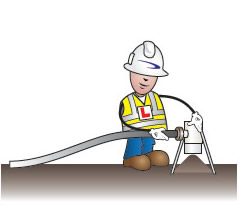 Concrete and screed and are essentially formed of the same basic ingredients – cement, aggregates and water. But what makes them different is- the size of aggregates, the cement grade, mix consistency, and of course their intended application or use.
Concrete and screed and are essentially formed of the same basic ingredients – cement, aggregates and water. But what makes them different is- the size of aggregates, the cement grade, mix consistency, and of course their intended application or use.
Composition and Mix Proportion
Concrete in its simplest form is a rock like mass formed by the hardening of cement paste and aggregates mixed in a proportion of – 1Cement: 2Sand: 3Coarse aggregates (ballast/gravel). But several variations are applied to this basic mix design to suit various uses and strength requirements.
Screed on the other hand is a thin layer of cement paste and sand/ fine aggregates, laid on to a concrete floor base or underfloor heating to act as a smooth flat levelling surface for taking on the final floor finish. Screeds generally follow a mix proportion of 1Cement: 3-5Sand (0-4mm washed sharp sand for levelling screeds).
For heavy duty screeds 25% of the 0-4mm sand is replaced by 6-10mm single sized aggregates, making the mix proportion 1:3:1 – cement:0-4mm sand:6-10mm single sized aggregates. This is done to facilitate trowelling and to increase the density of the screed.
Finish
Concrete has a range of uses as building material, as a wearing surface and in masonry. It can be given a range of finishes from coarse to extremely smooth, depending on the intended use of the concrete
In contrast, screed is used to create a smooth level surface for the final finish, and is not intended to be used as a final wearing surface. But screeds should be able to provide sufficient support and strength to withstand the traffic under its intended use.
Consistency of mix
Looking at consistency – concrete is mixed to a wetter consistency while the screed mix should be of a semi-dry, non-crumbly consistency. For concrete, the slump rates depend on the application and mix design.
Being a wetter mix, concrete is usually applied using floats or piston pumps, whereas the semi dry screeds are installed using pneumatic pumps or forced-action mixers. However, certain screeds that use an anhydrite base instead of cement are mixed to a free-flowing consistency and are applied using grout pumps/worm pumps.
| Screed | Concrete | |
| Application/use | A smooth, levelling layer or sub-floor laid over concrete floor base or underfloor heating to take on the final floor finish | For structural use, masonry and as final wearing surface |
| Mix Proportions | 1:3-5 (cement: sand)1:3:1 ( cement: 0-4mm sharp sand:6-10mm coarse aggregate) for heavy duty screed | 1:2:3 (cement: sand: coarse aggregate) |
| Cement grade | Ordinary 42.5N Portland CementIf using 32.5N Portland Cement, add an additional 10% cement to the original mix proportion | A wide variety of cement grades depending on design specification |
| Aggregate type | 0-4 mm washed sharp sand for cementitious levelling screed6-10mm single sized aggregate for heavy duty screeds | Fine Aggregate: Natural sand, manufactured sand, or a combination of both, with aggregate size smaller than 5mmCoarse Aggregate: Gravel, crushed gravel, crushed stone or crushed concrete, air cooled blast furnace slag with an aggregate size not exceeding 9.5 – 37.5 mm |
| Water | Clean potable water | Clean potable water |
| Mixconsistency | Semi-dry for cementitiousscreedsFree flowing for anhydrite screeds | Wet mix – the slump rates depend on the application and mix design. |
| Distribution Method | Pneumatic pump or forced action mixer for cementitious screedsWorm pump/grouting pump for anhydrite screeds | Piston pump or direct discharge from ready mix trucks. |
The basic chemistry is the same for both concrete and screed – the cement and water forms a paste and coats the surface of the sand or the aggregates, and the cement paste hardens by a process called hydration, forming a hardened mass of high strength and durability. But what alter the qualities of the mix to suit various uses are the proportioning, grades, mixing and consistency of the ingredients.







